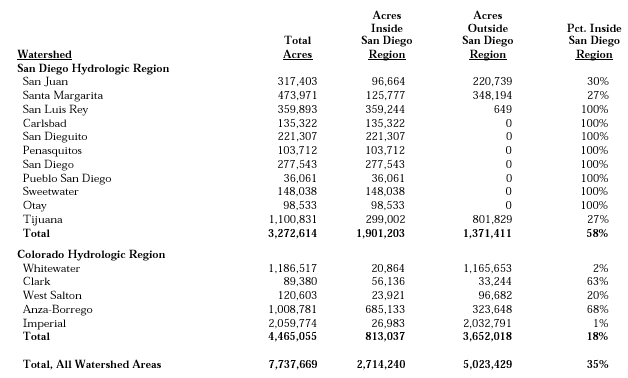
![]()

Activities in each watershed impact areas that are miles away, as runoff, sediment, and pollutants flow through the watershed toward its outlet. In whichever direction the watersheds extend, land use decisions in those areas affect the natural resources and water quality in this region.
The above table indicates the acreage of the 16 major watersheds in the San Diego region. It also indicates the acreage that lies within the boundaries of the San Diego region and the acreage that extends beyond the region's border. Of the 11 watersheds that make up the SDHR, seven are entirely within the San Diego region and one is almost entirely within the region (99.8% of its acreage), while the three others (San Juan, Santa Margarita, and Tijuana) have just over one-quarter of their area within the region. All five of the CHR watersheds are only partially within the San Diego region, ranging from just one percent of the Imperial watershed to 68 percent of the Anza-Borrego watershed.

GEOGRAPHIC SIZE OF WATERSHEDS IN THE SAN DIEGO REGION
Figure 1 Each of the watersheds in the San Diego region is unique in size, terrain, and development pattern. Of the San Diego Hydrologic HYDROLOGIC REGION Region (SDHR) watersheds, the Tijuana watershed is by far the largest in size, covering over 1.1 million acres. Nearly 300,000 Acres acres, or 27 percent of its area, are in the San Diego region (see Figure 1).
The second largest of the SDHR watersheds, Santa Margarita, is less than one-half the size of the Tijuana watershed. Like the Tijuana watershed, only 27 percent of its 474,000 acres are in the San Diego region.
The third largest of the SDHR watersheds, San Luis Rey (359,900acres) is located in the northwest portion of the region. It is almost entirely with the San Diego region boundaries.
The smallest of the SDHR watersheds, Pueblo San Diego (36,100acres), is located around the downtown area of the City of San Diego and is less than one-twentieth the size of the Tijuana watershed.
CHARACTERISTICS OF WATERSHEDS ENTIRELY WITHIN THE SAN DIEGO REGION
Note: As discussed previously, watersheds do not recognize political boundaries. Unfortunately, much of the information available to effectively 2,000,000 manage and preserve natural resources within those watershed areas often is limited by political boundaries. This section looks at existing and planned land use, land ownership, and current and forecasted population for the eight watersheds wholly within the San Diego region. (All of these 1,500,000 watersheds are in the San Diego Hydrologic Region.) Hopefully in the near future, this type of information will be standardized and available across geographic regions.
LAND USE
The conversion of natural land to developed uses affects the amount and type of pollutants that are generated and then flow through watersheds to coastal water bodies and the ocean. The effects on plant and animal species depend on many factors, including where and how homes are built, where new industry is located, where new infrastructure is built to support urban development, and where land is conserved. The conversion of land surface in the watershed also increases the amount and frequency of runoff, which impacts flood potential downstream. Flood control is an expensive and often Clark Tijuana ineffective attempt to alter the natural flow of runoff. The San Juan Imperial Whitewater potential for large floods in the San Diego region is high due to Anza-Borrego West Salton Santa Margarita the variability of precipitation and runoff. One of the most sensible alternatives to flood control is land use planning. Along San Diego Orange with zoning, building, and subdivision regulations, effective land use planning can limit the amount and type of development Riverside San Bernardino that occurs in floodplains and can reduce the impact of Imperial Mexico development in the watershed on downstream communities.
The above table outlines existing land uses that comprise each of the watersheds entirely within the San Diego region. Different types of land use impact watershed areas in different ways. Developed lands, whether residential or employment-related, create additional runoff that must be accommodated. Other uses, such as agriculture, may not affect runoff as much but may generate pollutants that then flow through the watershed to other areas and water bodies.
